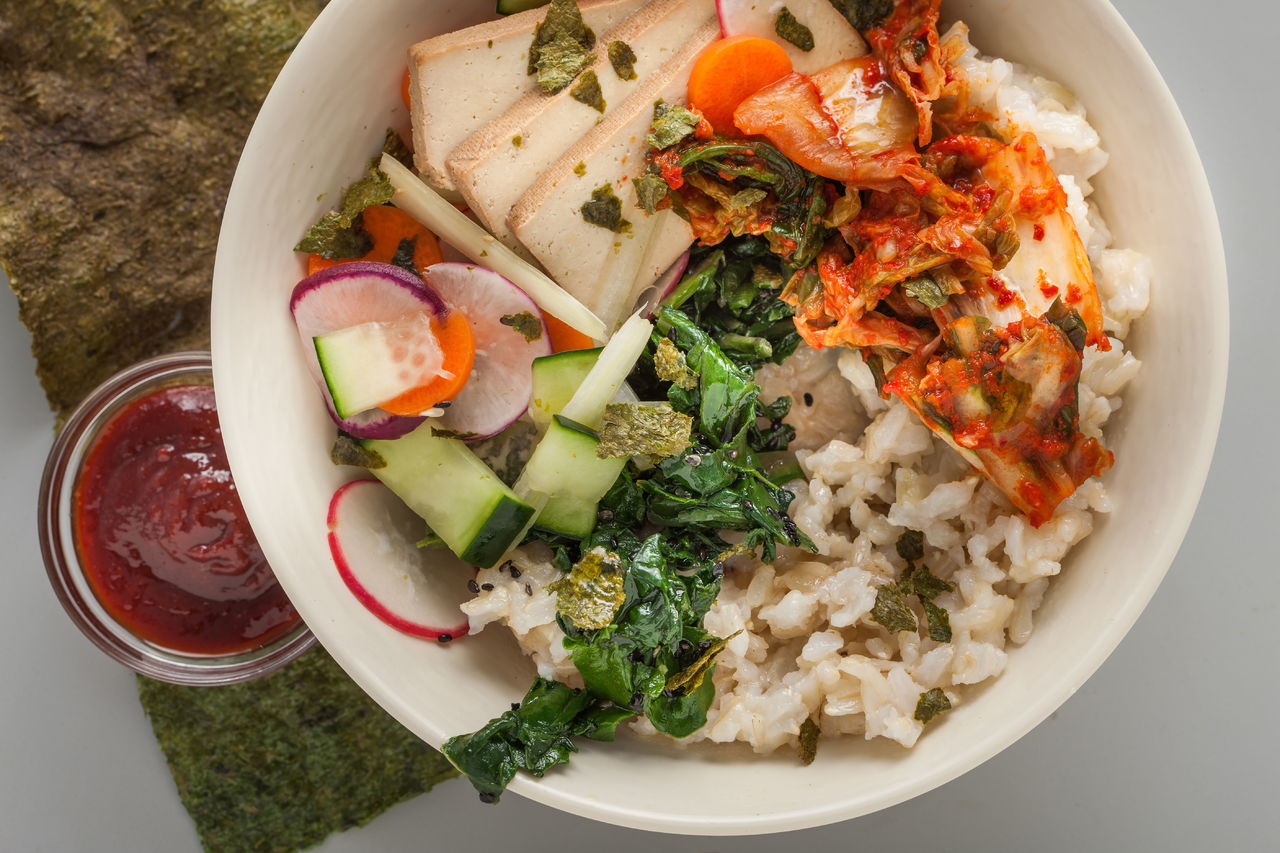Bibimbap seems tailor-made for the way I eat — and cook. Leftover protein, lightly cooked or raw vegetables, kimchi, rice, hot sauce: What’s not to like?
This traditional Korean dish (whose name means, simply enough, “mixed rice”) seems at home in any season, and with just about any combination of ingredients. The latter approach might not make your particular version seem all that traditional, but the fact is, there apparently are as many iterations of bibimbap in Korea as there are regional foods.
Ideally, no matter how closely you hew to the Korean formula, you want a gorgeous variety of color and texture. And although you can certainly serve it with plain leftover rice (white or brown, cold or warm), if you’ve got a little more time, don’t pass up the opportunity to crisp up the rice in a pan, imitating the effect of so-called dolsot bibimbap, which is served in a hot stone dish that comes to the table sizzling.
Bibimbap fits into the current craze for bowls: grain bowls, ramen, pho and more. And I found my new favorite bibimbap recipe in a book that celebrates them all: “Bowl,” by Lukas Volger (Houghton Mifflin Harcourt, 2016).
Bonus: Volger’s recipes are all vegetarian.
I focused on one he calls Spring Bibimbap, with its combination of kimchi, quick-pickled vegetables and sauteed Swiss chard (the latter sprinkled with black sesame seeds). When I couldn’t find any good-looking avocados, I subbed in some smoked tofu — which also afforded a little extra protein. I crisped the rice according to Volger’s directions.
Finally, I employed the mechanism that gives the dish its name. I arranged the little piles of ingredients on and around the rice in the bowl, dolloped in a little gochujang (a Korean chili sauce) and then, right before eating, I took my chopsticks and stirred — vigorously. The rice was mixed, and I was ready to eat.
Bibimbap with kimchi and smoked tofu
Make ahead: The rice needs to be made and refrigerated 1 day to 1 week in advance, so it can be easily crisped.
Find gochujang, a fermented Korean chili paste, in Asian markets and some large supermarkets.
1 pound Swiss chard
1 large Kirby cucumber or half a conventional cucumber, cut into ½-inch rounds
1 medium carrot, scrubbed and thinly sliced
6 small radishes, thinly sliced
1 tablespoon sugar
¾ teaspoon plus a pinch fine sea salt
2 tablespoons canola oil
2 teaspoons toasted sesame oil
1 tablespoon black sesame seeds (may substitute toasted white sesame seeds)
4 cups cold cooked brown or white rice
2 teaspoons rice vinegar, preferably unseasoned
Two 2-inch squares nori (toasted seaweed)
2 cups kimchi, chopped
8 ounces smoked tofu, cut into ¼-inch slices
Gochujang, for serving (see headnote; may substitute Sriracha)
Trim the stems from the Swiss chard. Tear the leaves into bite-size pieces. Reserve half of the stems for another use or discard them. Slice the remaining stems into 2-inch lengths, then into thin matchsticks, and transfer them to a medium bowl.
Stack the cucumber rounds and slice them into matchsticks. Add them to the bowl with the chard stems, along with the carrot and radish slices. Toss with the sugar and ¾ teaspoon of the salt; let stand as you prepare the rest of the meal.
Meanwhile, pour 1 tablespoon of the canola oil into a large skillet over medium heat. Use tongs to add the Swiss chard leaves in batches, as needed, adding more as each batch cooks down. Add the pinch of salt and cook, stirring frequently with the tongs, until the leaves are wilted and the pan is mostly dry, 3 to 4 minutes. Remove from the heat; use a spatula to push the greens to one side of the pan. Holding the chard in place and gently squeezing, tilt the pan over the sink to pour off any excess liquid. Transfer the chard to a bowl and stir in 1 teaspoon of sesame oil and the sesame seeds. Wipe out the skillet.
Just before serving, heat the remaining 1 tablespoon of canola oil and the remaining teaspoon of sesame oil in the skillet over medium heat. Press the rice into the skillet, making a thick cake. Cook, without stirring or shaking, until a golden brown crust forms on the bottom of the rice, 4 to 5 minutes.
Rinse and drain the sliced-vegetable mixture in a colander (wiping out the bowl it was in), then blot it dry with paper towels or a clean dish towel and return it to the bowl. Add the vinegar and toss to incorporate.
Wave the nori squares over the flame of a gas burner a few times, until the corners curl and they turn crisp. (Alternatively, roast them under a broiler for just a few seconds, watching carefully so they don’t burn.) Slice into thin strips with a chef’s knife, or crumble with your fingers.
To serve, use a spatula to scoop out the rice and divide it among four bowls, ensuring that everyone gets some of the crispy part. Top with the chard greens, kimchi, tofu and the vegetable mixture. Garnish with the nori and serve immediately, passing gochujang at the table.
Adapted from “Bowl,” by Lukas Volger (Houghton Mifflin Harcourt, 2016).
Talk to us
> Give us your news tips.
> Send us a letter to the editor.
> More Herald contact information.

























